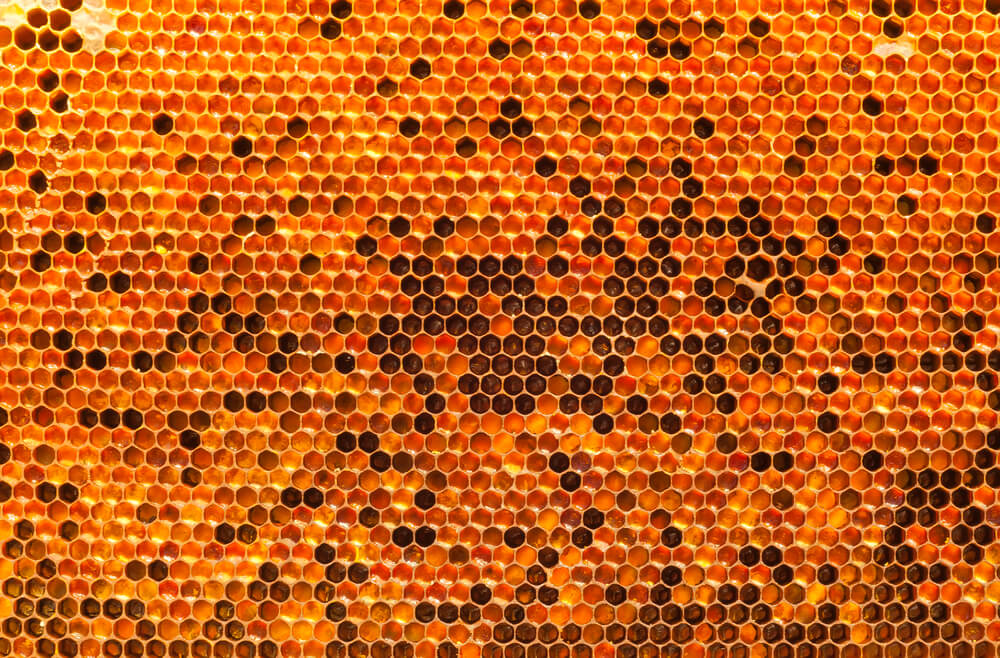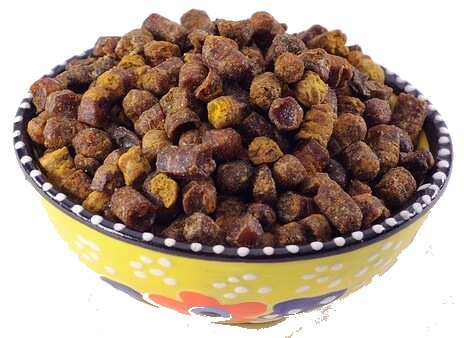Table of Contents:
What is Bees Bread?
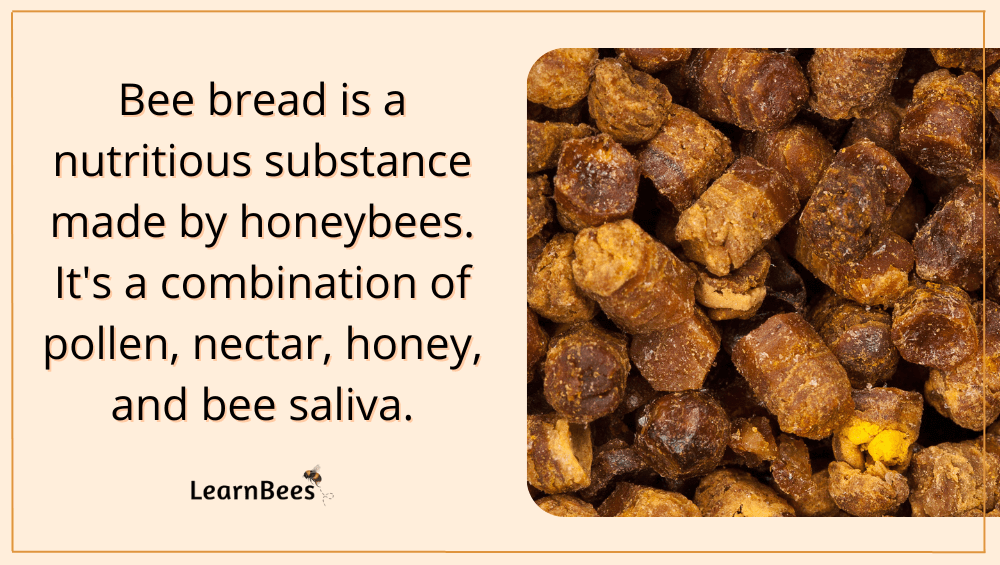
Bee bread is a nutritious substance produced by honeybees. It’s a mixture of pollen, nectar, honey, and bee saliva.
Adult bees make bee bread to feed baby bees (larvae). Bee bread is rich in protein and carbohydrates, which allow the young bees to have a well-rounded diet.
Now you might be asking:
How is bee bread made?
It all starts with a forager bee.
Forager bees are responsible for leaving the hive in search of food. They collect pollen and nectar from flowers to bring back to the nest. Their role is to help feed the colony.
And as the forager bees gather pollen, they mix it with nectar and a little saliva as they travel. From there, the bee bread is stored inside a honeycomb cell, where the bees add more nectar and saliva to it.
Finally, the enzymes in the bee’s saliva help break down the pollen to allow for easier digestion.
Why is this important?
Because pollen in its natural state is hard to digest.
So, bees use their special enzymes to alter the pollen and make it easy to eat.
What is Bees Bread Good For?
Bee bread is an essential part of a bee’s diet.
As mentioned, it provides the bees with their protein source. Protein is crucial because it allows the bees to build strong colonies and survive the winter.
Additionally, bees don’t eat raw pollen directly from the flower. They have to mix it with the enzymes from their saliva to make the pollen digestible. This is where bee bread comes from.
But what about for humans? Does bee bread have any benefits?
Here are a few:
Benefit 1: Bee Bread is High in Antioxidants That Can Protect Against Free Radicals and Diseases
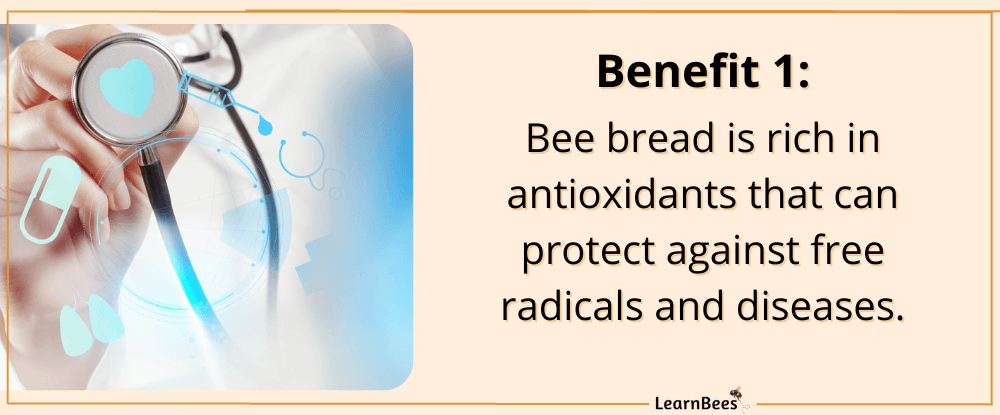
Bee bread contains many antioxidants, such as flavonoids, glutathione, carotenoids, quercetin, and kaempferol.(1)
Antioxidants protect your body against free radicals, which are potentially harmful molecules. Damage by free radicals is linked to chronic diseases such as type 2 diabetes and cancer.(2)
Additionally, some studies have shown that the antioxidants in bee bread can help decrease chronic inflammation, stop harmful bacteria, fight infections and combat the growth and spread of tumors.(3)
Benefit 2: Bee Bread May Boost Your Immune System to Help You Fight Illness
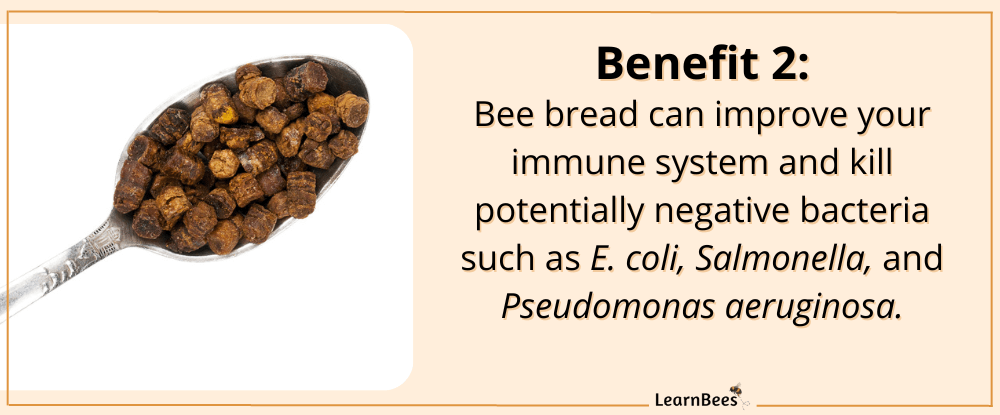
In one study, bee bread significantly reduced mast cell activation. Mast cells release chemicals that trigger an allergic reaction when they’re activated.(4)
Moreover, many test-tube studies have confirmed that bee bread has strong antibacterial properties.
Bee bread extract was discovered to kill potentially negative bacteria such as E. coli, Salmonella, and Pseudomonas aeruginosa, as well as those that lead to staph infections.(5, 6)
Benefit 3: Bee Bread Can Help Treat Skin Wounds
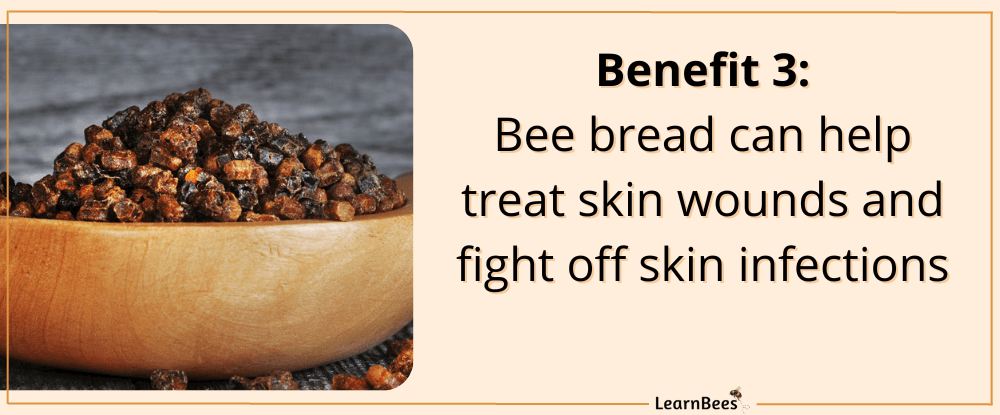
Thanks to its anti-inflammatory properties, bee bread can help your body with wound healing.
For example, bee bread was shown to be just as effective at treating burn wounds as silver sulfadiazine, which is a common burn treatment. Additionally, bee bread was shown to have far fewer side effects.(7)
Another animal study confirmed that applying an ointment containing bee bread onto a burn significantly accelerated healing over other treatments.(8)
Bee bread’s antibacterial qualities may also stop infections, a major risk factor that can compromise the healing process for scrapes, burns, cuts, and abrasions.(9)
Benefit 4: Bee Bread Has an Impressive Nutrient Profile
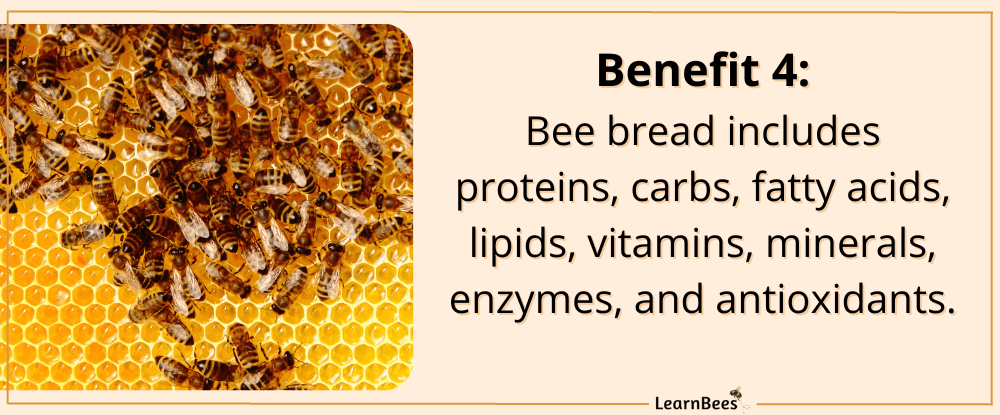
Bee bread consists of over 250 biologically active substances. This includes proteins, carbs, fatty acids, lipids, vitamins, minerals, enzymes, and antioxidants.(10)
Bee pollen granules include approximately (11):
- Protein: 35%
- Carbs: 40%
- Water: 4–10%
- Fats: 5%
- Other substances: 5–15%
The “other substances” category consists of minerals, vitamins, antibiotics, and antioxidants.
With that in mind, the pollen’s nutritional content depends on which plants the bees pollinated. For example, pollen collected from date palm contains about 35% protein, while pine plants have about 7%.(12)
Benefit 5: Bee Bread May Help Lower the Risk of Heart Disease

Heart disease is the number one cause of death globally.
High blood cholesterol and high blood lipids can lead to an increased risk of heart disease.
Some research suggests that bee bread may reduce these risk factors.
For example, animal studies have shown that bee bread extracts can decrease blood cholesterol levels, notably “bad” LDL cholesterol.(13, 14)
Furthermore, antioxidants found in bee bread may protect lipids from oxidation. When lipids oxidize, they can stick together, which restricts blood vessels and increases your heart disease risk. (15)
How Do I Eat Bees Bread?
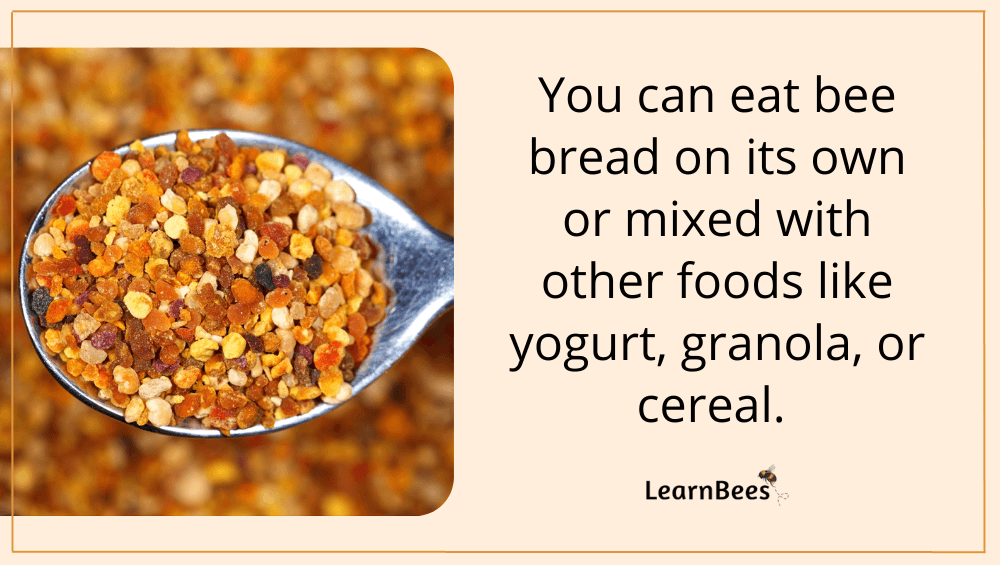
You can eat bee bread on its own or add it to other foods.
Some ways to add bee bread to your diet include:
- Adding it to smoothies or yogurt
- Sprinkling it on top of cereal, oatmeal, or toast
- Mixing it into salad dressings or dipping sauces
- Adding it to homemade energy bars or granola
Bee bread can be found by a local beekeeper, at some farmer’s markets, or online.
Bee bread should not be given to children under the age of one. This is because bee bread may contain small amounts of honey, which can potentially lead to infant botulism.(16)
Infant botulism is a rare but serious foodborne illness that affects babies. Babies contract infant botulism when the bacteria spores enter their intestines and produce toxins. Side effects include weak cries, trouble breathing, constipation, and diminished gag reflexes.(17)
FAQs on Bees Bread
- What is bee bread made from?
- What is bee bread called?
- Is bee bread a good supplement?
- Is it safe to eat bee bread?
- Is bee bread a superfood?
- Is bee bread the same as honeycomb?
- Who feeds bees bread?
- What is the difference between bee bread and honey?
- What does bee bread smell like?
- When should you eat bee bread?
- What are the side effects of bee bread?
- Is bee bread anti-aging?
What is bee bread made from? What is bee bread made of?
Bee bread is created by honeybees and is a mixture of pollen, nectar, honey, and bee saliva.
This substance is the primary food source for adult honeybees and their young. The exact makeup of the bee bread varies depending on which flowers the bees forage from. Flower availability changes depending on seasons and climate.
Researchers have discovered that bees add extra enzymes and microorganisms (such as helpful bacteria) to the bee bread. These additions help to make the pollen more digestible and release amino acids and other nutrients.
—> Go back to the FAQs on “What is Bees Bread?”
More to Explore:
What is bee bread called?
Bee bread is also known as bee pollen or ambrosia. Bee bread is a ball or pellet-like substance consisting of pollen, nectar, honey, and bee saliva.
—> Go back to the FAQs on “What is Bees Bread?”
More to Explore:
Is bee bread a good supplement?
Yes, bee bread is a good source of vitamins, amino acids, and macro and micronutrients for humans.
For bees, bee bread is crucial to their survival. Adult bees and larvae eat bee bread as their primary source of protein.
Bees collect pollen from flowers and mix it with nectar, honey, and saliva. This mixture is then stored in the hive and used as needed. Beekeepers will harvest bee bread for human consumption.
—> Go back to the FAQs on “What is Bees Bread?”
More to Explore:
Is it safe to eat bee bread?
Yes, bee bread is considered safe to eat for most adults.
That said, children under one should not consume bee bread as it may contain small amounts of honey. Honey can lead to a rare but serious foodborne illness called infant botulism.
As with anything, starting small and eating bee bread in moderation is best. It can be eaten on its own or sprinkled onto foods of your choice. For example, bee bread can be added to yogurt, salads, or smoothies.
—> Go back to the FAQs on “What is Bees Bread?”
More to Explore:
Is bee bread a superfood?
The word “superfood” is a reasonably new word referring to foods with high nutritional benefits for minimal calories. Bee bread is nutrient-dense, containing vitamins, minerals, and antioxidants, but it’s unclear whether we can label it as a superfood.
Common superfoods include chia seeds, kale, spinach, and berries.
However, bee bread does come with some health benefits, including:
1. Boosting immunity
2. Reducing inflammation
3. Fighting off skin infections
—> Go back to the FAQs on “What is Bees Bread?”
More to Explore:
Is bee bread the same as honeycomb?
No. A honeycomb is a yellow substance that honeybees make to store honey. It’s made of beeswax and formed into hexagonal cells that are connected. Honeybees also use combs to raise their young.
Since honeycomb is made of beeswax, it’s not something most people eat by itself. You can, however, eat honeycomb along with honey. But honeycomb by itself is simply beeswax that doesn’t provide any nutritional value.
Bee bread is a ball or pellet-like substance consisting of pollen, nectar, honey, and bee saliva. Bee bread is a good source of vitamins, amino acids, and other nutrients for humans.
Additionally, bees rely on bee bread as their primary source of protein. So, while honeycomb is just beeswax, bee bread is a nutritious and beneficial food for humans and bees.
—> Go back to the FAQs on “What is Bees Bread?”
More to Explore:
Who feeds bees bread?
Adult forager bees are responsible for collecting the food to make bee bread. They collect both pollen and nectar from flowers. From there, they bring the pollen and nectar back to the nest so it can be used.
Adult bees feed the larvae bee bread. The larvae later mature into adult bees, and the cycle starts again.
Beekeepers may also harvest bee bread to sell or use themselves. It can be eaten on its own or added to food.
—> Go back to the FAQs on “What is Bees Bread?”
More to Explore:
What is the difference between bee bread and honey?
Honey is the sweet, syrup-like substance that bees store for food during the winter.
Honey comes in many flavors depending upon which flowers the honeybees visit. For instance, clover honey comes from bees who pollinate clover flowers. Blueberry honey comes from bees that pollinate blueberry flowers.
Each type of honey has a unique flavor, texture, and color.
In contrast, bee bread is more uniform in texture and color. Most bee bread is formed into pellets with a yellow, brownish color.
Bee bread is a mixture consisting primarily of pollen. But it also includes honey, nectar, and bee saliva.
—> Go back to the FAQs on “What is Bees Bread?”
More to Explore:
- Ground Bees: Are They a Threat to Your Yard?
- Wasps vs. Honeybees: Are They Different?
- Do Bumble Bees Bite?
What does bee bread smell like?
Bee bread typically has a sweet yeasty smell.
—> Go back to the FAQs on “What is Bees Bread?”
More to Explore:
When should you eat bee bread? How do you take bee bread?
You can eat bee bread any way you like it. Some people eat it straight from the hive with nothing else mixed in. Others mix bee bread in with their granola, smoothies, or cereal.
We recommend trying a spoonful or two of bee bread on its own first, then mixing it with other ingredients as you wish.
—> Go back to the FAQs on “What is Bees Bread?”
More to Explore:
- Do Carpenter Bees Pollinate?
- How Long Do Bumble Bees Live?
- Honeybees vs. Bumblebees: How Do They Compare?
What are the side effects of bee bread?
The one thing to consider with bee bread is that it may contain small amounts of honey. Children should not eat honey under one year of age as it may contain botulism spores.
Other than that, there are no known side effects of bee bread.
—> Go back to the FAQs on “What is Bees Bread?”
More to Explore:
- Do Queen Bees Eat Honey?
- Are Worker Bees Male or Female?
- Queen Bee Versus Worker Bees – How Do They Compare?
Is bee bread anti-aging?
There is no known research suggesting that bee bread is anti-aging. Overall, a well-balanced diet, exercise, and skincare routine are the best anti-aging methods to follow.
